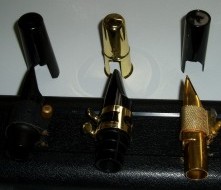
Cool, good to hear from you.
In general:
Metal mouthpieces have a ‘brighter’ sound and you can project more (more volume). Their volume is smaller which changes the air flow a bit- makes it faster.
Hard rubber pieces have a ‘darker’ sound and a fatter bottom- more overtones, etc.
Hard rubber sounds better than plastic… so plastic’s okay when you’re starting off, but when you want to go past that you probably want hard rubber.
I would say hard rubber has the best sound overall. Metal does have a different sound, so a lot of it is personal preference.
Using amplification, the volume factor isn’t as important as it used to be. But metal could help for like something like a marching band.
Generally, in ‘legitimate'(orchestra, concert band, etc) music- you’ll get funny looks if you try and play a metal mouthpiece. And besides the funny looks, it’s difficult to play softly on metal.
The size of the tip opening is very important too. You get more edge and brightness with a more open piece and it should correspond inversely with the strength of your reed- ie wider opening with softer reed.
I like the Vandoren V16 hard rubber pieces- I have them on tenor and alto. Have heard good things about Morgans. Meyers used to be very good, the new ones aren’t as good. Other mouthpieces that have the same name from years ago (like Otto Link) have changed a lot.
-Neal



I’ve been making mouthpieces for twenty-eight years and used to think that the material made a big difference and that metal was brighter too but now I know it’s not true. A lot of people still believe it but more and more players are realizing that it’s not true anymore.
I have a CNC (Computer Numerically Controlled) milling machine. This is a machine that cuts different materials within ten thousandths of an inch accuracy and I proceeded to make the same design with a variety of different materials. I used solid sterling silver, brass, copper and black ebony, the same wood that they make high-end clarinets from. The end result was that they all sounded the same.
I realize this is extremely difficult to believe but it’s true. The sax simply doesn’t vibrate enough to influence the sound. A great book to read is “Fundamentals of Musical Acoustics by Banade. I may not have the correct spelling of his last name. His book has a large part dedicated to woodwind instruments. If you really want to do something other than speculate I recommend reading it.
Phil Barone
Hey Phil,
I was curious about that. Was wondering if the build and shape of a metal mouthpiece made more difference to the sound than the metal itself.
I actually studied some acoustics in school (degree in applied physics) and I related some of it to music, but in general it had other applications that we were looking out. I’ll check out that book, thanks
-Neal